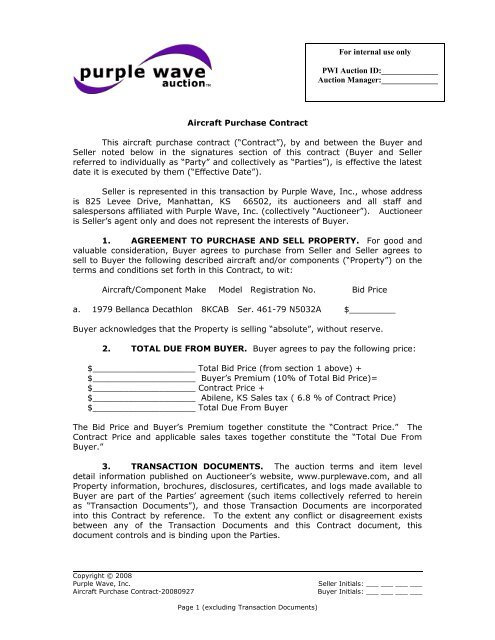
Aircraft Sales Contract: Secure Your Purchase with Confidence
Aircraft sales contracts are pivotal documents that formalize the transfer of ownership rights and responsibilities between aircraft sellers and buyers. Crafting a solid aircraft sales contract involves understanding essential components and legal considerations to ensure a smooth and legally binding transaction. This detailed guide explores the key elements of a robust aircraft sales contract and important legal considerations that buyers and sellers should be aware of.
- Understanding the Purpose of an Aircraft Sales Contract
1.1 Defining the Transaction The aircraft sales contract serves as the legal agreement outlining the terms and conditions of the sale, including the aircraft’s specifications, purchase price, payment terms, delivery arrangements, warranties, and other pertinent details.
1.2 Formalizing the Agreement It formalizes the agreement between the seller and buyer, providing clarity on their rights, obligations, and expectations throughout the sales process and after the transfer of ownership.
- Essential Components of an Aircraft Sales Contract
2.1 Identification of Parties Clearly identify the seller (individual or entity) and buyer (individual or entity) involved in the transaction, including their full legal names, addresses, and contact information.
2.2 Aircraft Details Provide detailed information about the aircraft being sold, including its make, model, year of manufacture, serial number, registration number, airworthiness certificate, and any modifications or upgrades.
2.3 Purchase Price and Payment Terms Specify the agreed-upon purchase price for the aircraft, payment methods (e.g., lump sum, installment payments), deposit requirements, payment schedule, and currency of payment.
2.4 Delivery and Acceptance Outline the terms of aircraft delivery, including the location, method of delivery (e.g., flight ferry, ground transportation), delivery timeline, and procedures for acceptance or rejection of the aircraft upon delivery.
2.5 Warranties and Representations Include any warranties or representations made by the seller regarding the aircraft’s condition, maintenance history, title, legal status, and compliance with aviation regulations.
2.6 Inspections and Due Diligence Specify provisions for pre-purchase inspections, buyer’s due diligence, and any conditions or rights related to inspection results, discrepancies, or deficiencies found during the inspection process.
2.7 Title Transfer and Registration Address the transfer of title and registration of the aircraft, including the seller’s responsibility for providing clear title, lien releases, and necessary documentation for registration in the buyer’s name.
2.8 Risk of Loss and Insurance Allocate the risk of loss between the parties during the contract period, define insurance requirements (e.g., liability insurance, hull insurance), and determine responsibility for insurance coverage during delivery and transit.
2.9 Closing Conditions Include any conditions precedent to closing the sale, such as regulatory approvals, financing contingencies, clear title verification, and other factors that must be satisfied before the sale can be finalized.
2.10 Governing Law and Dispute Resolution Specify the governing law that will apply to the contract (e.g., state or federal laws), the jurisdiction for resolving disputes (e.g., courts, arbitration), and the process for resolving disputes or claims arising from the contract.
- Legal Considerations in Aircraft Sales Contracts
3.1 Compliance with Aviation Regulations Ensure that the contract complies with applicable aviation laws, regulations, and industry standards, including FAA regulations for aircraft transactions in the United States.
3.2 Tax Implications Consider the tax implications of the aircraft sale, including sales tax, use tax, registration fees, and any exemptions or concessions available based on the transaction details and jurisdiction.
3.3 Liens and Encumbrances Address any existing liens, mortgages, or encumbrances on the aircraft, and outline the seller’s responsibility for clearing these encumbrances before the transfer of ownership.
3.4 Title Search and Clear Title Conduct a thorough title search to verify the aircraft’s ownership history, ensure clear title transfer, and mitigate risks associated with undisclosed liens, disputes, or ownership claims.
3.5 Confidentiality and Non-Disclosure Include provisions for confidentiality and non-disclosure to protect sensitive information shared during the sales process, including proprietary data, financial details, and trade secrets.
3.6 Legal Review and Expert Advice Seek legal counsel or aviation experts to review the contract, identify potential legal issues or risks, and ensure that the contract accurately reflects the intentions and agreements of both parties.
- Best Practices for Crafting a Solid Aircraft Sales Contract
4.1 Clarity and Precision Use clear, concise language, and avoid ambiguous or vague terms that may lead to misinterpretation or disputes. Define key terms, provisions, and responsibilities in detail.
4.2 Completeness and Accuracy Ensure that the contract includes all essential components, terms, and conditions relevant to the aircraft sale, leaving no room for misunderstandings or omissions.
4.3 Customization and Flexibility Tailor the contract to the specific details of the aircraft sale, considering factors such as aircraft type, condition, financing arrangements, delivery logistics, and other unique aspects of the transaction.
4.4 Review and Negotiation Allow both parties sufficient time to review, negotiate, and seek clarification on any provisions or terms before signing the contract. Address any concerns or discrepancies through mutual agreement.
4.5 Documentation and Recordkeeping Maintain accurate records of all contract documents, communications, amendments, and related correspondence to establish a clear record of the transaction and protect against future disputes.
- Conclusion
Crafting a solid aircraft sales contract requires attention to detail, legal expertise, and adherence to industry standards and best practices. By including essential components, addressing legal considerations, and following best practices, parties can create a robust and enforceable contract that protects their interests, promotes transparency, and facilitates a successful aircraft sale transaction.



